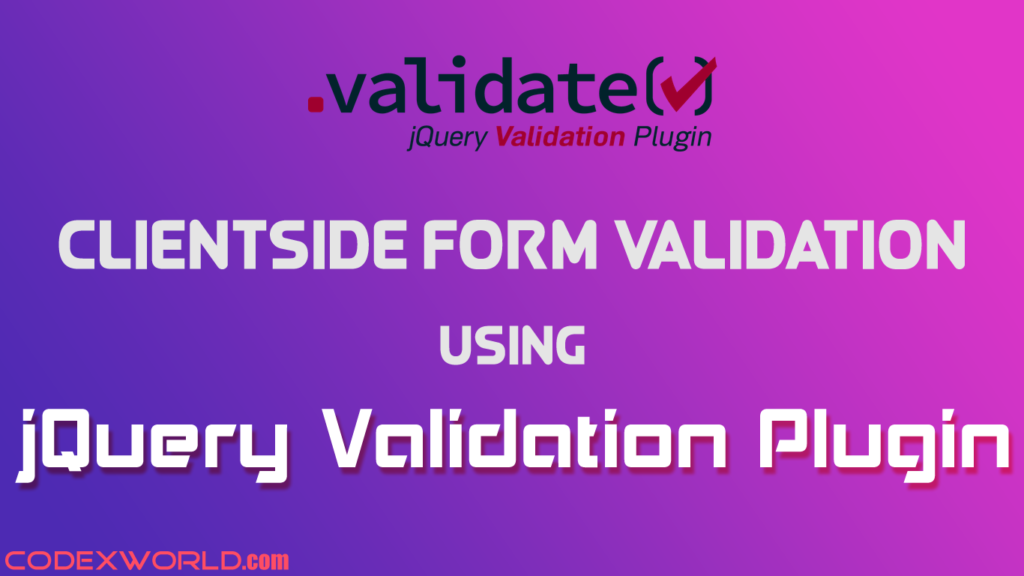close

Client-side form validation is very useful for validating a form and it makes your web project more user-friendly. You can found many ways to perform client-side validation in HTML form, but jQuery Validation Plugin is the easiest way to validate a form. The jQuery Validation Plugin lets you implement form validation instantly with many customization options.
This tutorial will show you how to integrate client-side form validation using jQuery validation plugin. Also, this example form validation code will help you to use custom validation rules and messages. In the sample script, we’ll demonstrate a registration form validation with different rules and custom messages.
To use jQuery Validation Plugin you need to include the jQuery library (jquery.min.js) and jQuery validation plugin library (jquery.validate.js).
<script src="jquery.min.js"></script> <script src="jquery.validate.js"></script>
The validate() method is used to validate a form based on the selector provided.
rules are key/value pairs defining custom rules. Key is the name of an element and value is an object consisting of rule/parameter pairs or a plain String.
messages are key/value pairs defining custom messages. Key is the name of an element and value is a message to display for respective element.
$(document).ready(function() { $("#userForm").validate({ rules: { name: "required", email: { required: true, email: true }, phone: { required: true, number: true }, url: { required: false, url: true }, username: { required: true, minlength: 6 }, password: { required: true, minlength: 6 }, confirm_password: { required: true, minlength: 6, equalTo: "#password" }, agree: "required" }, messages: { name: "Please enter your name", email: "Please enter a valid email address", phone: { required: "Please enter your phone number", number: "Please enter only numeric value" }, url: { url: "Please enter valid url" }, username: { required: "Please enter a username", minlength: "Your username must consist of at least 6 characters" }, password: { required: "Please provide a password", minlength: "Your password must be at least 6 characters long" }, confirm_password: { required: "Please provide a password", minlength: "Your password must be at least 6 characters long", equalTo: "Please enter the same password as above" }, agree: "Please accept our policy" } }); });
The user registration form HTML which is validated with jQuery Validation Plugin.
<form class="userform" id="userForm" method="post" action=""> <p> <label for="name">Name</label> <input id="name" name="name" type="text" > </p> <p> <label for="email">E-Mail</label> <input id="email" type="email" name="email" > </p> <p> <label for="phone">Phone</label> <input id="phone" type="phone" name="phone" > </p> <p> <label for="url">URL</label> <input id="url" type="url" name="url"> </p> <p> <label for="username">Username</label> <input id="username" name="username" type="text"> </p> <p> <label for="password">Password</label> <input id="password" name="password" type="password"> </p> <p> <label for="confirm_password">Confirm password</label> <input id="confirm_password" name="confirm_password" type="password"> </p> <p> <label for="agree">Please agree to our policy</label> <input type="checkbox" class="checkbox" id="agree" name="agree"> </p> <p> <input class="submit" type="submit" value="Submit"> </p> </form>
The following CSS is used to styling the form and error message.
.userform{width: 400px;} .userform p { width: 100%; } .userform label { width: 120px; color: #333; float: left; } input.error { border: 1px dotted red; } label.error{ width: 100%; color: red; font-style: italic; margin-left: 120px; margin-bottom: 5px; } .userform input.submit { margin-left: 120px; }
Here we’ve used mostly used validation methods, you can also use many other validation rules as per your requirement. See the list of built-in Validation methods from Plugin website.
Do you want to get implementation help, or enhance the functionality of this script? Click here to Submit Service Request
thanks, sir this article is very helpful for me
so useful
Useful Tutorial